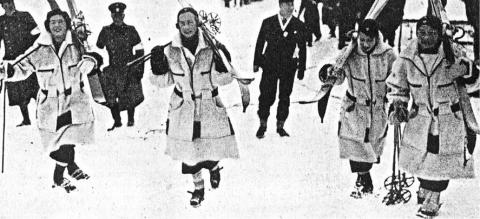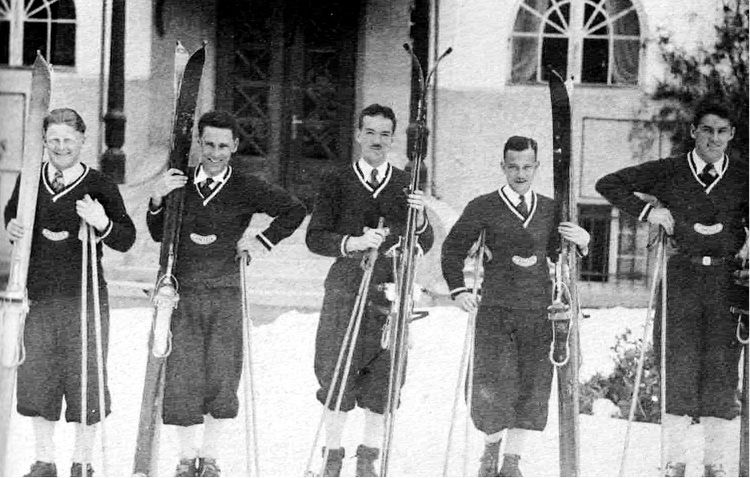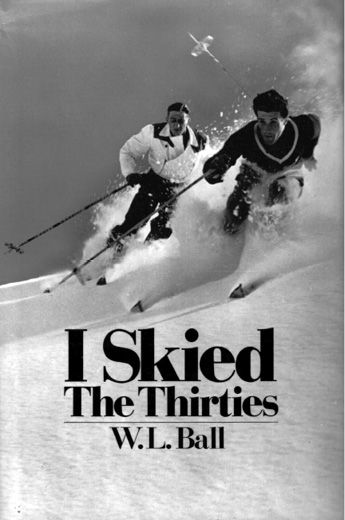
By Lori Knowles
The first Alpine Olympians had a lot to learn.
Imagine the courage. The excitement! The adventure! Being young and spry and Canadian in the pre-war 1930s, devoted to an obscure, hearty little sport called “ski-ing.” And imagine the thrill, in the midst of a Great Depression, to be named to the team representing Canada in the first Olympic Winter Games to feature Alpine skiing. It must have been intoxicating. It must have been thrilling. One can hear the rally cry:
Here we come, 1936 Olympics in Garmisch-Partenkirchen! We’ve got our steel-edged skis and our plus-four pants, and we’re boarding the RMS Duchess of Atholl to cross the Atlantic to ski for king and Canada. We’ll beat the Americans. We’ll trounce the Scandinavians. We’ll sock it to the Nazis!
That’s the way it might have been for the members of Canada’s first Olympic Alpine ski team. The reality was far more sobering.
(Photo top: The Canadian women's Alpine team, 1936 -- left to right: Diana Gordon-Lennox, Lois Butler, Marion Miller and Edwina Chamier. Canadian Ski Yearbook)

Bill Ball, Norman Gagne, Karl Baadsvik.
Bill Ball: I Skied the Thirties..
The Men’s Team
In the spring of 1935, a committee met in Montreal to name the male athletes to represent Canada at the world’s first Olympic slalom and downhill events: Tom Mobraaten (Vancouver), Bud Clark (Ottawa), and three from Montreal, Bill Ball, Norman Gagne and Karl Baadsvik. Three more bowed out early—Hans Gunnarson (Revelstoke) due to lack of finances, and Peter and Lukin Robinson (Toronto), two brothers who, having lived in Switzerland, refused to compete in Hitler’s Germany. The team was led by coach and manager Harry Pangman, a cross-country skiing Olympian from the 1932 Lake Placid games.
The sea voyage in January 1936 was “decidedly unpleasant.” In his book I Skied the Thirties, Ball outlined the team’s plan to hit the gym an hour each day and dine extravagantly at the captain’s table. But, as he recalled, few had “the stomach for it.” They disembarked behind schedule several sick days later in Greenock, Scotland. Dashing down the east coast of England to the docks at Grimsby, they hastily boarded a 2,000-ton steamer headed for Hamburg, Germany. After 11 days, massive sea swells, gale-force winds and roiling stomachs, Canada’s weary men’s team trundled by train into the Bavarian town of Garmisch to begin training.
The Women’s Team
It was different for the women. Unable to fund transatlantic passages for a ladies’ ski team, the Olympic committee decided—surprise, surprise—that Canada wouldn’t send one. Instead, four Canadians living in Europe who had some experience racing in the Alps—three married, one single, ranging in age from 24 to 38—would represent the country. Stepping up to serve were Mrs. Lois Butler (captain), Mrs. Diana Gordon-Lennox, Miss Marion Miller and Mrs. Edwina Chaumier (and, yes, honorifics were listed).
The women were only partially ready. They’d spent January 1936 training gates at Mürren, Switzerland. But “the conditions all over the Alps were terribly bad,” Butler wrote in the 1936 Canadian Ski Yearbook. “It rained, thawed, froze or blew a gale of wind almost every day for weeks, but it never seemed to snow,” she continued. “Old men went about murmuring ‘the worst season for 50 years!’” The team was forced to practice slalom “between rocks and bushes.”
More bad luck: sickness and injury. Chaumier cracked a bone in her foot. Gordon-Lennox—a monocle-wearing socialite and always a finish-line favorite—busted two bones in her left hand. Butler fell ill with the flu. And Miller was dogged by a nasty bout of bronchitis. Wrote Butler: “It certainly did not look as though we would ever reach the start at Garmisch.”
But reach it they did, on January 25, 1936. There to greet them was the ragged band of Canadian men with their own list of ailments and injuries. Coach Pangman accompanied team members on 17 trips to the X-ray lab and more than two dozen visits to the Garmisch hospital—all in the two weeks leading up to the February 6 opening ceremonies. Said Pangman, “I began to think that it was not Canada’s year and even began to fear I would have to get out and run myself!”
Hitler’s Opening Ceremonies
Snow fell prettily on Garmisch-Partenkirchen during opening ceremonies. With Alpine skiing billed as the Games’ star attraction, Canadian ski team members marched directly behind the flag bearers—ahead of the figure skaters, ahead of the speed skaters, ahead, even, of Canada’s revered hockey players. Ball described the day: “We got into our natty dark blue uniforms with the maple leaves on the pockets of the jackets, our plus-four pants and our white cable knit socks.” A 400-piece band played national anthems. Some teams gave the Nazi salute, others refused; Hitler stood on a balcony looking severe. He raised his right arm as he said: “I declare the fourth Winter Olympic Games open…”
The Neuner Downhill
Early the next morning, skiers were called out into darkness for the downhill. They rode taxis, then cable cars, then traversed Nordic-style across an expanse of deep snow to reach the start of the Neuner, the most treacherous downhill in Bavaria. “The same course was used for both men and women,” wrote Ball, “except the ladies’ course omitted the first 500 feet vertical through the sparse spruce woods with its 120-degree turn at the bottom… almost immediately, however, the course dropped another 500 vertical feet as it wound back and forth down a 38-degree slope in narrow S turns.” He went on to label the downhill as “very bumpy” and “hard to stand up on.”
Butler was more sanguine: “The new snow had stayed on the slopes and except for occasional patches of ice, the course was lovely. After two falls, and many uncertain moments, and what seemed to be a tremendous amount of hard work, I found myself over the finish line.” Butler placed 17th in the downhill, followed by Chaumier (25th) and Miller (28th). Christl Cranz (born in Brussels but skiing for Germany) was favored to win—everyone was intimidated by the size and skill of the German women’s team. But it was Canada’s Gordon-Lennox who stole the show. She crossed the finish line in 31st place as the crowd went wild. Wrote Ball: “Monocle screwed firmly in her right eye and grasping two feet of pole (for balance, she claimed) in her injured left hand… [she received] a tremendous ovation.” Butler concurred: “Diana arrived, greeted with cheers, because with her broken arm in a plaster, her eye-glass, her fluent Viennese German and her enormous sense of humor, she was quite the most popular skier in Garmisch.”
Coach Pangman said the Canadian men’s team skied “creditably if not brilliantly.” With Mobraaten too injured to race the downhill and Gagne focused solely on ski jumping, Baadsvik placed 26th, Ball 39th, and Clark 47th. In the top spot with a four-second lead: Norway’s Birger Ruud, who raced with a bandaged head after being knocked unconscious in training. Pangman watched the race alongside some 10,000 spectators near the Steilhang, an icy, 350-foot drop that ended at a flat bridge over a mountain stream. He sang the praises of the victors, who, as he said, shot out of the woods, traversed high and turned around flags “with the slightest puff of snow from their skis” before pointing them straight down toward the overpass. Less-skilled racers, he said, “practically crawled out of the woods and then fell two or three times before making the bridge, and usually [fell] again on it!”

Bill Ball
The Slalom
The slalom was no less exciting. Canada’s men finished in the middle of the pack, led again by Baadsvik and followed by Ball and Clark—same as the downhill. But the grace and speed of the Norwegian and German victors gave Pangman something of an epiphany. Canadian skiers were going at it all wrong, he said, skiing with outdated techniques that wouldn’t cut the mustard on this more modern, more aggressive Olympic stage. “Here in Europe weighting of the skis were absent,” Pangman wrote in his report. “The runners made no sudden stops and very rarely used a stem but took everything without a change of pace.” The result, Pangman wrote, was “smooth, powerful, unstoppable!”
As for the Canadian women, Butler jetted across the line as Canada’s top finisher in the 19th spot, Miller was 29th and Chaumier was 31st. Yet once again it was the monocle-wearing Gordon-Lennox who wowed the cheering crowd of 30,000 spectators. Butler’s tongue was firmly in cheek when she recounted her friend’s finish in 28th place: “Diana received almost as great a cheer as Christl Cranz,” she wrote in the Yearbook. “In fact, Mr. Arnold Lunn, the originator of downhill racing, who was taking no notice of her run down, as he really did not expect her to win, paused for a moment in a discourse on Einstein to say, ‘What’s the matter, Diana, have you won?’” 
Lori Knowles is a Canadian ski writer and managing editor of Ski Canada magazine.
This article is part of the Canadian Ski History Writers Project, an ongoing collaboration between the Canadian Ski Hall of Fame and Museum and the International Skiing History Association.
Editor’s Note:
1936 Olympic Alpine medals went to the combined winners of slalom and downhill.
- Men
- Gold: Franz Pfnur (GER)
- Silver: Güstav Lantschner (GER)
- Bronze: Émile Allais (FRA)
- Women
- Gold: Christl Cranz (GER)
- Silver: Käthe Grasegger (GER)
- Bronze: Laila Schou Nilsen (NOR)
